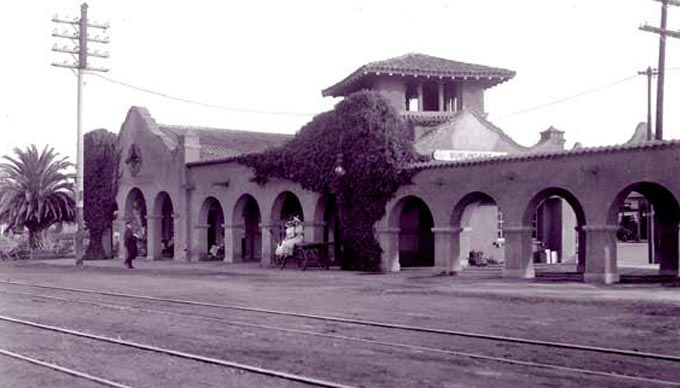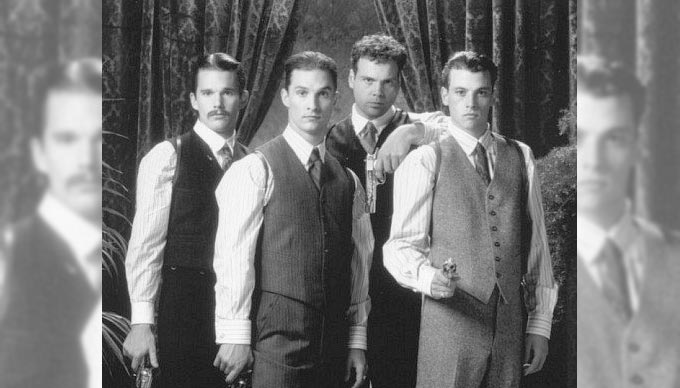Uvalde is a legendary “Wild West” town at the southwest corner of our Hill Country map. Known mostly for its outlaws during the early years, Uvalde produced several much-more-positive role models during the 20th century.
 Wikipedia
Wikipedia
History
Wild West Legends in Uvalde

Photo: thestoryoftexas.com
The Uvalde area’s recorded history began largely with the establishment of San Antonio in 1718; from that time on, the region was crossed frequently by Spanish soldiers, traders, hunters, and prospectors. A mission (Nuestra Senora de la Candelaria) was established in 1762, about thirty miles northwest of present-day Uvalde; while it lasted only about five years before it was abandoned due to attacks by Comanches, Governor Juan de Ugalde defeated an army of Apaches near the site of modern-day Utopia (northeast of Uvalde) in 1790. The Sabinal Canyon was then known as the Canon de Ugalde. In 1849 (after Texas had joined the United States), a trail through the area to El Paso was marked by famous scout Jose Policarpo “Polly” Rodriguez, and Fort Inge was built a mile south of the current city center to protect settlers from Indian attacks.
One of the very few settlers then living west of Castroville (founded in 1844, a few miles west of San Antonio) was a rugged veteran of the Mexican War named Edward Dixon Westfall. He had built a cabin on the banks of the Leona River, and lived there with only his dogs for company; when the fort was built, he hired on as a scout for the U.S. Army. In 1853, a 23-year-old man named Reading W. Black purchased 4,650 acres (at 50 cents an acre) and built himself a home about a mile north of the fort. In 1855, he hired a surveyor from San Antonio to lay out an impressive city (which he first called Encina) on his piece of the wild, wild west.

Photo: thestoryoftexas.com
The dubious surveyor, C.A. Thielpape, followed Black’s directions and surveyed four plazas and 100-foot-wide streets at the “city center.” A few more settlers arrived, and soon there was a store, a blacksmith shop, and a grist mill. In 1856, a new county was formed; the town’s name was changed to Uvalde (a corruption of Ugalde, the name of the heroic governor from the previous century) and it became the county seat of the new Uvalde County. A post office opened in 1857.
For the next three decades, Uvalde was one of the wildest and most lawless of all the western towns. Comanche attacks killed many of the early settlers, and the surrounding area became a haven for outlaws. Intermittent battles with Mexico added to the dangers, and the abandonment of Fort Inge during the Civil War led to a redoubling of Comanche raids.
A Confederate soldier named W.W. Hartsell described a five-day march from San Antonio to Uvalde in 1861, and remarked that Uvalde was “a rather desolate-looking place. A courthouse, blacksmith shop, a grocery store and half a dozen dwellings constitute the county seat.” (The gristmill was a short distance upstream.)

Photo: Wikipedia
Uvalde County voters had opposed secession by a 76-16 margin, and bitterness between Union and Confederate sympathizers continued long after the war was over. Reading Black, the town’s founder and a representative in the Texas legislature was assassinated in 1867. The tax assessor and collector were protected by armed guards, and the county was without a sheriff for two years; the acting sheriff in 1873 was none other than the murderous outlaw, King Fisher. Louis L’Amour chose Uvalde for the opening scene in his novel, Sackett, where Tell Sackett shoots a card shark sometime shortly after the Civil War and has to leave town.
Uvalde acquired a link with the civilized world in 1881, when the Galveston, Harrisburg, and San Antonio Railway came through, and the town began a period of rapid growth. By 1888, the city of Uvalde was incorporated, and by 1890, the census counted 2,000 inhabitants. That was the year that a young lawyer named John Nance Garner arrived in Uvalde; he ran for the office of county judge in 1893 against a rancher’s daughter named Mariette Rheiner. The political opponents fell in love, and were married in 1895!
The next 30 years were good for Garner and for Uvalde. Garner was elected to the U.S. Congress in 1903 and worked his way up to Speaker of the House in 1931; he was considered as a leading candidate for president in 1932, but supported Franklin D. Roosevelt and became one of the chief architects of the New Deal as Roosevelt’s vice-president. In the meantime, Uvalde grew into a prosperous regional center. Railroads were built from Uvalde to Crystal City (in 1911) and to Camp Wood (in 1921); by 1940, the population was over 5,000, and Uvalde had 200 businesses, plus multiple churches, beautiful neighborhoods, large hotels, an excellent school system, a beautiful opera house and a large, modern fairground which included a race track and stables. Tourism had become an important industry, and Garner State Park opened 26 miles north of Uvalde in 1941, the same year that Garner Army Air Field opened in Uvalde.

Photo: IMDb
Uvalde still had its rough edges, even as it grew and prospered. A young man named Willis Newton robbed a train in Uvalde in 1914, on his way to becoming the leader of the legendary “Newton Boys” bank robber gang. He and his younger brother, Joe, retired to Uvalde in the 1940s. But Uvalde by then was an established, respectable town, and the Newtons’ notoriety only added to its prestige. the economy was mostly agricultural; Uvalde produced mohair, pecans, honey and many other crops. There were also several mines and a fish hatchery in Uvalde County. Southwest Texas Junior College was established in Uvalde in 1946.
Uvalde continued to grow through the second half of the 20th century, and one of those who helped lead that growth was Dolph Briscoe, a Uvalde High School valedictorian who went on to become governor of Texas from 1973 to 1979. Governor Briscoe was a hugely successful rancher and businessman who became the largest individual landowner in the state of Texas and who also served as chairman of the board for the First state Bank of Uvalde. His philanthropic work included the renovation of Uvalde’s Grand Opera House and many other local projects.
Two other celebrities who were born in Uvalde are the late singer/actress Dale Evans and the current movie actor Matthew McConaughey, who played the part of Willis Newton in the 1998 movie, “The Newton Boys.”

Photo: Wikipedia
Uvalde today is a vibrant, prosperous community of more than 15,000 residents. With a great variety of shopping, dining and lodging options, plus a number of museums and recreational opportunities, Uvalde makes a great “home base” for numerous day trips in each direction. Just to the north and west are some of the most scenic spots in Texas, including Garner State Park, Lost Maples State Natural Area, Kickapoo Caverns State Natural Area and a number of sparkling rivers and quaint Hill Country towns. To the south and west are the National Fish Hatchery, Cook’s Slough Sanctuary and Nature Park, Fort Inge, Fort Clark and John Wayne’s Alamo Village at Brackettville. All around Uvalde are wonderful places for hunting, horseback riding, bird watching, tubing, or just enjoying the spectacular scenery.
One of the unique attractions in Uvalde is the Sahawe Indian Outdoor Theater, home of the amazing Boy Scout and Girl Scout group known as the Sahawe Indian Dancers. These youngsters have become Uvalde’s favorite goodwill ambassadors, as they take their authentically detailed costumes and choreographed dances all around Texas in a 60-year tradition of excellence. Other highlights are the Briscoe Art & Antique Collection, the Aviation Museum at Garner field, the Janey Slaughter Briscoe Grand Opera House, the John Nance Garner Museum and the 18-hole Uvalde Memorial Golf Course. For more information, visit the Uvalde Chamber of Commerce at www.visituvalde.com.

